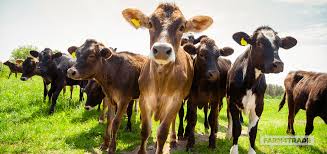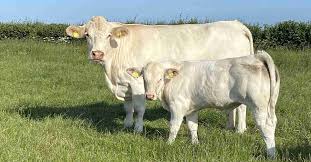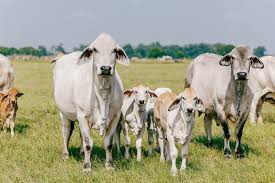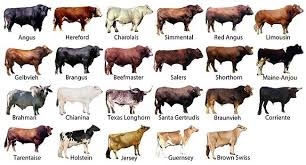beef breeds are developed specifically for their meat quality and yield. Beef breeds of cattle, in contrast to their dairy counterparts, are selectively bred for their muscle development, growth rate, and overall carcass quality.
These breeds are known for their ability to convert feed efficiently into meat, making them crucial for meat production in the agricultural industry. They typically possess a stockier build, with broader bodies and more pronounced muscles, which contribute to higher meat yields.
Different beef breeds also exhibit unique traits, such as fat marbling, tenderness, and flavor, influencing the marketability and culinary appeal of the meat.
Among the prominent beef breeds, Angus is widely recognized for its excellent meat quality and marbling, leading to tender and flavorful cuts.
Originating from Scotland, Angus cattle are predominantly black and known for their adaptability to various climates and farming systems. They are also a popular choice among farmers due to their ease of calving and efficient feed conversion.
Hereford, another renowned breed, is distinguished by its white face and red body. This breed is celebrated for its hardiness and ability to thrive in diverse environments, making it a favorite among beef producers.
Additionally, the Charolais breed, originating from France, is known for its lean meat and high yield, often leading to premium prices in the market. Charolais cattle are typically light cream to white in color and are characterized by their muscular build. They are often crossed with other breeds to enhance growth rates and meat quality.
The Simmental breed is also noteworthy, as it is one of the oldest and most widely distributed beef breeds globally. Recognized for its rapid growth and milk production capabilities, Simmental cattle are often raised for both beef and dairy purposes.
In addition to these well-known breeds, there are many other beef cattle breeds, each with unique traits and advantages. For instance, Limousin cattle, known for their efficient weight gain and lean meat, are favored in commercial beef production.
The Brahman breed, with its distinctive hump and resistance to heat and pests, is particularly suited for tropical regions and is often used in crossbreeding programs to enhance hardiness in offspring.
The choice of beef breed can significantly impact the profitability and sustainability of a cattle operation. Factors such as climate, pasture quality, and market demands play a crucial role in determining which breed will thrive in a specific environment.
Producers must carefully consider these elements to select the best beef cattle breed for their operation, balancing meat quality, growth rates, and adaptability to ensure long-term success in the competitive meat industry.
Importance of Beef Cattle in Agriculture

1. Source of Protein: Beef cattle are a primary source of meat, providing protein that is vital for human nutrition. This protein is crucial for muscle development and overall health.
2. Economic Contribution: The beef industry significantly contributes to the agricultural economy. It creates jobs in farming, processing, and distribution, boosting local economies.
3. Utilization of Land: Beef cattle can graze on land that is not suitable for crop production. This helps in utilizing natural resources efficiently and maintaining pastureland.
4. By-products: Besides meat, beef cattle produce valuable by-products, such as leather, which is used in various industries, and manure, which serves as a natural fertilizer for crops.
5. Cultural Significance: In many cultures, beef is an important part of traditional diets and celebrations. Beef cattle farming can also be a significant aspect of rural life and heritage.
Major Beef Breeds and Their Characteristics
Different beef breeds have unique characteristics that affect their growth, meat quality, and adaptability. Here are some of the major beef breeds:
1. Angus: Known for their black coat, Angus cattle are highly regarded for their meat quality. They produce tender, marbled beef, making them a favorite among consumers.
2. Hereford: Recognizable by their white face and red body, Hereford cattle are known for their docile temperament and ability to thrive in various climates.
3. Charolais: These white cattle are renowned for their muscular build and high-quality meat. They are often crossed with other breeds to enhance meat quality.
4. Simmental: Simmentals are large, dual-purpose cattle known for their milk production and meat quality. They have a distinctive yellow-red coat with white markings.
5. Limousin: With a reddish-gold coat, Limousin cattle are known for their lean meat and high yield. They are efficient converters of feed into weight gain.
Angus: A Popular Choice for Quality Meat
1. Characteristics: Angus cattle are typically black, but some may be red. They are medium to large in size, with a strong build and good muscling.
2. Meat Quality: Angus beef is known for its excellent marbling, which enhances flavor and tenderness. This quality has led to the breed’s popularity among consumers and chefs.
3. Adaptability: Angus cattle are adaptable to various environments, from colder regions to warmer climates. Their resilience helps farmers raise them in diverse conditions.
4. Reproductive Efficiency: Angus cattle have good reproductive traits, including early maturity and a strong maternal instinct. This results in higher calf production and efficient herd management.
5. Health Benefits: Angus beef is often marketed as a healthier option, as it tends to have lower fat content compared to other breeds. The breed’s genetics contribute to leaner meat with a higher omega-3 fatty acid content.
Hereford: Recognized for Its Hardiness
1. Characteristics: Hereford cattle are easily identified by their distinctive white faces and reddish-brown bodies. They are medium to large-sized animals known for their robust and sturdy build.
2. Hardiness: Herefords are well-suited to various climatic conditions, making them a popular choice among farmers in different regions. Their adaptability allows them to thrive in both hot and cold environments.
3. Meat Quality: Hereford beef is known for its rich flavor and tenderness. The breed produces high-quality marbled meat, which is highly sought after in the market, contributing to its popularity among beef producers.
Read Also: 12 Medicinal Health Benefits of Alangium chinense (Chinese Alangium)
Charolais: Known for Its Growth Rate

1. Characteristics: Charolais cattle are typically cream or white in color, with a strong and muscular appearance. They are known for their large size and well-defined musculature.
2. Growth Rate: Charolais are recognized for their impressive growth rates, making them an excellent choice for commercial beef production. They can reach market weight more quickly than many other breeds, allowing farmers to capitalize on shorter production cycles.
3. Meat Quality: The meat from Charolais cattle is lean, with minimal fat cover and high yields. This breed is favored for producing premium cuts of beef, appealing to both processors and consumers.
Simmental: Dual-Purpose Breed for Milk and Meat
1. Characteristics: Simmental cattle have a striking appearance, typically characterized by their gold or red coats with white patches. They are large and muscular animals with a calm disposition.
2. Dual Purpose: Simmentals are known for their versatility, serving both as milk and beef producers. They can provide a good amount of milk while also producing quality meat, making them valuable for mixed farming operations.
3. Growth and Milk Production: Simmental cattle have excellent growth rates and can produce a significant quantity of milk. This dual-purpose nature allows farmers to diversify their income streams.
Limousin: Lean Meat with High Yield
1. Characteristics: Limousin cattle are typically reddish-gold in color and are recognized for their muscular build. They are medium to large-sized animals with a lean appearance.
2. Lean Meat Production: Limousins are renowned for producing lean cuts of beef with low fat content. This characteristic appeals to health-conscious consumers and has made Limousin beef increasingly popular in the market.
3. High Yield: Limousin cattle are known for their high yield of quality meat. They have an efficient feed-to-gain ratio, allowing farmers to maximize profitability while minimizing feed costs.
Shorthorn: Versatile and Easy to Handle
1. Characteristics: Shorthorn cattle come in a variety of colors, including red, white, and roan. They have a stocky build, are medium to large in size, and are known for their calm temperament.
2. Versatility: Shorthorns are recognized for their versatility, as they can be raised for both milk and meat production. This adaptability makes them a popular choice among farmers looking to diversify their operations.
3. Ease of Handling: One of the significant advantages of Shorthorn cattle is their gentle disposition, making them easier to handle. This trait is beneficial for farmers, especially those who may be inexperienced in managing livestock.
Read Also: Poultry Disease Prevention and Management
Brahman: Resilient in Hot Climates

1. Characteristics: Brahman cattle are easily identifiable by their distinctive hump over their shoulders, loose skin, and large, droopy ears. They are typically gray or light red in color and are known for their muscular build.
2. Resilience: Brahmans are highly resilient animals that thrive in hot and humid climates. Their adaptability to heat and disease resistance makes them ideal for regions where other breeds may struggle.
3. Meat Quality: While Brahman cattle may not produce as much marbling as some other breeds, they are known for their lean, high-quality meat. The breed is often crossed with other beef breeds to improve the overall quality of the offspring.
Selecting the Right Breed for Your Farm
1. Assess Your Goals: Before choosing a breed, consider your farming goals. Are you focusing on meat production, milk production, or both? Identifying your primary objective will help narrow down your options.
2. Evaluate Your Environment: Different breeds thrive in various climates and conditions. For example, Brahman cattle excel in hot, humid environments, while other breeds may perform better in cooler regions. Evaluate your local climate and terrain when selecting a breed.
3. Consider Market Demand: Research the demand for different beef types in your area. Some breeds may be more popular among consumers, affecting market prices. Understanding consumer preferences can guide your breed selection.
4. Review Available Resources: Consider the resources you have available, such as feed, land, and water. Some breeds may require more intensive management and resources than others. Assess your capacity to provide adequate care for your chosen breed.
5. Seek Expert Advice: Consulting with local agricultural extension services, experienced farmers, or breed associations can provide valuable insights. They can help you understand which breeds are best suited for your specific circumstances.
Do you have any questions, suggestions, or contributions? If so, please feel free to use the comment box below to share your thoughts. We also encourage you to kindly share this information with others who might benefit from it. Since we can’t reach everyone at once, we truly appreciate your help in spreading the word. Thank you so much for your support and for sharing!
Read Also: The External Marketing Environment

